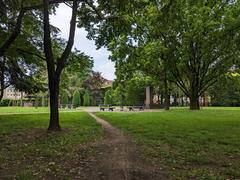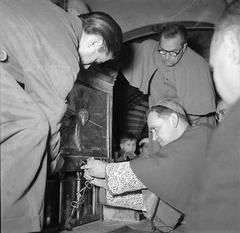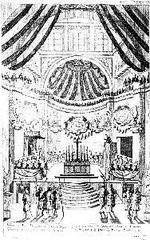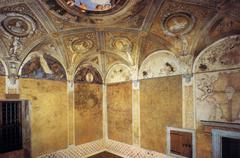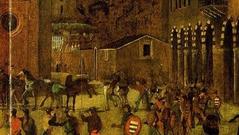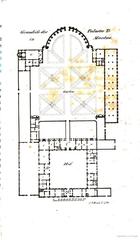Former Church of San Zenone Visiting Hours Tickets and Historical Significance in Mantua
Date: 03/07/2025
Introduction to the Former Church of San Zenone in Mantua
Nestled within the historic core of Mantua, Italy, the Former Church of San Zenone stands as a remarkable emblem of the city’s layered religious and architectural heritage. With origins tracing back to the medieval period, likely between the 11th and 12th centuries, San Zenone reflects the spiritual life and urban development of a city that flourished under the Gonzaga dynasty and evolved through significant artistic movements such as Romanesque, Gothic, and Renaissance styles. Dedicated to Saint Zeno, the revered bishop of Verona, this former parish church played a critical role in the daily religious practices and communal identity of Mantua’s inhabitants, serving as a focal point for rites of passage and neighborhood cohesion.
Though overshadowed by the grandeur of Mantua’s major basilicas, San Zenone offers visitors a unique window into the everyday ecclesiastical architecture and local artistry that collectively shaped the city’s cultural tapestry. The church’s Romanesque foundations—with thick masonry walls and small arched windows—combined with later Gothic and Renaissance interventions, illustrate the dynamic architectural evolution characteristic of Lombardy. Despite its deconsecration and secular adaptation following Napoleonic suppressions, San Zenone remains an essential piece of Mantua’s UNESCO World Heritage-listed historic center, embodying the resilience and adaptive reuse of sacred spaces.
Visitors today can explore San Zenone’s artistic remnants, including fresco fragments and sculptural capitals, while appreciating its proximity to key landmarks such as Piazza Sordello, Palazzo Ducale, and the Basilica di Sant’Andrea. Practical information on visiting hours, ticketing, accessibility, and guided tours equips travelers with the tools to plan an enriching visit to this hidden gem. Whether you are an art enthusiast, history buff, or cultural traveler, the Former Church of San Zenone invites you to uncover the intimate spiritual and architectural narratives woven into Mantua’s urban fabric (Visit Italy, Travel Connect Experience, World Heritage Site).
Table of Contents
- Origins and Early History
- Architectural Evolution
- Cultural and Religious Significance
- Notable Events and Historical Context
- Architectural and Urban Context
- Visitor Information: San Zenone Mantua Visiting Hours, Tickets, and More
- Visuals and Media
- Frequently Asked Questions (FAQ)
- Internal Links
- Call to Action
Visiting the Former Church of San Zenone in Mantua: History, Tickets, and Travel Tips
Origins and Early History
The Former Church of San Zenone in Mantua, Italy, stands as a testament to the city’s layered religious and architectural history. While Mantua’s origins trace back to the Etruscans and its urban fabric flourished under the Gonzaga dynasty (World Heritage Site), the Church of San Zenone itself is believed to have medieval roots, likely established between the 11th and 12th centuries. The dedication to Saint Zeno, a revered bishop of Verona, reflects the widespread veneration of this saint in northern Italy during the Middle Ages.
San Zenone’s foundation coincided with a period of ecclesiastical expansion in Mantua, as the city’s strategic location in the Po Valley fostered the growth of religious institutions. The church originally served as a parish center for the local community, providing spiritual services and acting as a focal point for neighborhood identity.
Architectural Evolution
Romanesque Beginnings
The earliest architectural phase of San Zenone likely featured Romanesque elements, characterized by thick walls, small arched windows, and a simple, rectangular nave. This style was prevalent in Lombardy during the 11th and 12th centuries, as seen in other Mantuan churches of the era. The use of brick and local stone would have been typical, reflecting the region’s building traditions.
Renaissance Transformations
Mantua’s transformation into a Renaissance hub under the Gonzaga family (ruling from 1328 to 1707) brought significant changes to its religious architecture (Visit Italy). While the grandest projects—such as the Basilica di Sant’Andrea and the Church of Santa Maria Assunta—received the most attention, smaller churches like San Zenone were also influenced by the era’s artistic currents. It is likely that San Zenone underwent renovations during the 15th or 16th centuries, incorporating Renaissance features such as larger windows, decorative frescoes, and perhaps a more articulated façade.
Later Modifications and Secularization
By the 18th and 19th centuries, as Mantua’s political and religious landscape shifted, many churches experienced functional changes. The suppression of religious orders during the Napoleonic era and subsequent secularization led to the closure or repurposing of several ecclesiastical buildings. San Zenone, like other former churches in Mantua, was eventually deconsecrated and adapted for secular use, which may have included storage, civic functions, or private ownership. This transition often resulted in the loss or alteration of original liturgical furnishings and artworks.
Cultural and Religious Significance
Parish Life and Community Role
For centuries, San Zenone played a vital role in the spiritual and social life of its parishioners. As a neighborhood church, it hosted baptisms, marriages, funerals, and feast day celebrations, anchoring the rhythms of daily life. The church’s dedication to Saint Zeno connected Mantua to the broader religious traditions of northern Italy, where the saint was invoked for protection against floods and as a patron of fishermen.
Artistic Heritage
While San Zenone may not have housed masterpieces on the scale of Andrea Mantegna’s frescoes in the Palazzo Ducale (Such Italy), it likely featured locally commissioned artworks, such as altarpieces, devotional paintings, and sculpted decorations. These works would have reflected the evolving tastes of Mantuan patrons, from medieval iconography to Renaissance naturalism.
Gonzaga Patronage and Urban Identity
The Gonzaga dynasty’s patronage of the arts and architecture profoundly shaped Mantua’s urban landscape (Visit Italy). While the family’s focus was on monumental projects, their influence extended to parish churches, which benefited from the city’s overall prosperity and artistic innovation. San Zenone’s evolution mirrors the broader narrative of Mantua’s rise as a Renaissance center, where even modest churches contributed to the city’s cultural fabric.
Notable Events and Historical Context
Medieval and Renaissance Milestones
Throughout its history, San Zenone would have witnessed key events in Mantua’s development, from the city’s medieval consolidation to its Renaissance flowering. The church likely played a role during religious processions, civic celebrations, and periods of crisis, such as plagues or wars. Its bells would have marked significant moments, calling the faithful to prayer or signaling emergencies.
Napoleonic Suppression and Aftermath
The late 18th and early 19th centuries brought dramatic changes to Mantua’s religious institutions. The Napoleonic occupation led to the suppression of many churches and monasteries, with their properties confiscated or repurposed (World Heritage Site). San Zenone’s deconsecration fits within this broader pattern, reflecting the secularization that swept across northern Italy during this era.
Modern Rediscovery and Preservation
In the 20th and 21st centuries, Mantua’s historic center—including its former churches—gained renewed attention as part of the city’s UNESCO World Heritage designation in 2008 (Visit Italy). This recognition highlighted the exceptional testimony of Mantua’s urban and architectural achievements, encouraging preservation efforts and adaptive reuse of historic buildings. Former churches like San Zenone are now appreciated not only for their religious past but also as integral elements of Mantua’s cultural landscape.
Architectural and Urban Context
Relationship to Mantua’s Historic Core
San Zenone is situated within Mantua’s historic core, an area renowned for its concentration of Renaissance architecture and urban planning (World Heritage Site). The church’s proximity to major landmarks—such as Piazza Sordello, the Ducal Palace, and the city’s lakes—places it within the heart of Mantua’s UNESCO-listed zone. This setting allows visitors to appreciate the interplay between religious, civic, and residential spaces that define the city’s unique character.
Comparative Significance
While San Zenone may not rival the scale or fame of Mantua’s principal churches, its story is emblematic of the many smaller religious sites that collectively shaped the city’s identity. These former parish churches provide insight into the everyday lives of Mantua’s inhabitants and the diffusion of artistic and architectural trends beyond the grandest monuments.
Visitor Information: San Zenone Mantua Visiting Hours, Tickets, and More
-
Visiting Hours: As a former church now used primarily for cultural events and exhibitions, opening hours can vary. Visitors are advised to check the Mantua tourism website or local guides for current visiting hours.
-
Tickets: Entry to San Zenone is often free when open to the public; however, some special exhibitions or guided tours may require a ticket. Prices typically range from €5 to €10.
-
Accessibility: The site is partially accessible to visitors with mobility impairments, though some historical architectural features may limit full access. It is recommended to inquire in advance.
-
Guided Tours: Organized guided tours are occasionally available through Mantua’s official tourism office or local tour operators. These tours offer deeper insights into San Zenone’s history and its role in Mantua’s cultural heritage.
-
Nearby Attractions: San Zenone is conveniently located near Piazza Sordello, the Ducal Palace, and Mantua’s scenic lakes, making it easy to combine a visit with other historical sites. Several cafes and restaurants in the area provide a pleasant setting for a break.
Visuals and Media
Alt text: The brick facade of the Former Church of San Zenone in Mantua showcasing Renaissance architectural features.
Alt text: Colorful Renaissance frescoes inside the Former Church of San Zenone in Mantua.
Interactive virtual tours and maps are available through Mantua’s official tourism website, providing an immersive experience for remote visitors.
Frequently Asked Questions (FAQ)
Q: What are the opening hours for the Former Church of San Zenone in Mantua? A: Opening hours vary depending on events and exhibitions. It is best to check the official Mantua tourism website or local visitor centers for the latest information.
Q: Is there an entrance fee or tickets required to visit San Zenone? A: Entry is generally free, but some special exhibitions or guided tours may charge a small fee.
Q: Is the Former Church of San Zenone accessible for people with disabilities? A: Partial accessibility is available, but due to the historic nature of the building, some areas may be challenging to access. Contact local tourist information for details.
Q: Are guided tours available at San Zenone? A: Guided tours are occasionally offered by local operators and the Mantua tourism office. Advance booking is recommended.
Q: What other historical sites can I visit near San Zenone? A: Nearby landmarks include Piazza Sordello, the Ducal Palace, and the scenic lakes of Mantua, all within walking distance.
Internal Links
For more about Mantua’s rich cultural heritage, see our articles on The Ducal Palace of Mantua and Exploring Mantua’s Renaissance Architecture.
Call to Action
Discover more hidden gems like San Zenone and plan your perfect visit to Mantua by downloading the Audiala app, your ultimate travel companion. Stay updated with the latest travel tips, guided tours, and cultural events. Follow us on social media for inspiring content and exclusive offers!
For additional details on Mantua’s UNESCO World Heritage status and its architectural treasures, visit Visit Italy and World Heritage Site.
Discover San Zenone: A Must-Visit Mantua Historical Site
Introduction
Nestled near the heart of Mantua’s historic center, the Former Church of San Zenone, also known as San Zenone all’Arco, stands as a captivating example of the city’s rich medieval and Renaissance heritage. This article explores San Zenone’s architectural evolution, artistic treasures, and practical visitor information including San Zenone visiting hours, tickets, accessibility, and travel tips to help you plan your visit to one of Mantua’s most intriguing historical sites.
Architectural Evolution and Styles
Romanesque Foundations
Dating back to the 11th century, San Zenone features Romanesque foundations characterized by thick masonry walls, small arched windows, and a sense of sturdy simplicity. Though urban development and renovations have altered much of the original structure, visitors can still observe Romanesque elements in the church’s lower walls and remnants of its original apse (travelconnectexperience.net).
Gothic and Renaissance Interventions
During the 13th and 14th centuries, Gothic influences were introduced, evident in pointed arches and decorative portals. Later, Renaissance touches, though more subtle than in nearby landmarks like the Basilica di Sant’Andrea, include frescoes and altarpieces reflecting Mantua’s artistic flourishing under the Gonzaga family (italythisway.com).
Artistic Significance
Frescoes and Decorative Programs
San Zenone’s interior frescoes, depicting scenes from the life of Saint Zeno and Marian themes, offer a glimpse into the devotional and artistic traditions of Mantua’s medieval and Renaissance communities. Surviving fragments, some housed in local museums, showcase vibrant colors and intricate decorative borders (travelconnectexperience.net).
Sculptural and Liturgical Elements
The church’s sculptural program includes Romanesque capitals with vegetal motifs and later Gothic and Renaissance reliefs. Its 16th-century polychrome marble altar and early baptismal font exemplify evolving ecclesiastical art in Mantua (italythisway.com).
Integration with Mantua’s Urban Fabric
Located near Piazza Sordello, San Zenone harmonizes with Mantua’s UNESCO-listed historic center. The Gonzaga family’s patronage ensured the church’s upkeep and artistic embellishment, reinforcing its role as both a spiritual and cultural landmark (notaboutthemiles.com).
Visiting San Zenone: Practical Information
San Zenone Visiting Hours and Tickets
- Visiting Hours: San Zenone is generally open to visitors Tuesday through Sunday from 9:00 AM to 6:00 PM. Hours may vary during holidays, so check the official Mantua tourism website before your visit.
- Tickets: Entry is free; however, donations are appreciated to support ongoing conservation efforts.
Accessibility
The church is wheelchair accessible with ramps available at the main entrance. The surrounding pedestrian-friendly historic center makes it easy to reach on foot from major squares like Piazza Sordello.
Guided Tours and Special Events
Guided tours providing detailed historical and artistic insights are available through local tourism offices. San Zenone frequently hosts chamber music concerts and cultural events, taking advantage of its excellent acoustics and intimate atmosphere (walksofitaly.com).
Nearby Attractions
Visitors are encouraged to combine their visit to San Zenone with other Mantua historical sites such as the Palazzo Ducale, Rotonda di San Lorenzo, and Basilica di Sant’Andrea for a comprehensive exploration of the city’s artistic heritage (notaboutthemiles.com).
Visitor Experience Highlights
- Façade and Portal: Observe the blend of Romanesque solidity with Gothic elegance.
- Interior Frescoes: Seek fresco fragments portraying Saint Zeno’s life.
- Sculptural Details: Admire capitals and reliefs showcasing medieval craftsmanship.
- Liturgical Furnishings: View the polychrome altar and ancient baptismal font.
Frequently Asked Questions (FAQ)
Q: Is there an entrance fee to visit San Zenone? A: No, entry is free though donations are welcome.
Q: Are guided tours available at San Zenone? A: Yes, local tour operators offer guided tours that include San Zenone.
Q: What are the San Zenone visiting hours? A: Typically 9:00 AM to 6:00 PM from Tuesday to Sunday; verify ahead for holidays.
Q: Is San Zenone accessible for visitors with mobility issues? A: Yes, the church is wheelchair accessible.
Q: Can I take photos inside San Zenone? A: Photography is generally allowed, but please be mindful of ongoing events or restoration.
Visuals and Media
Throughout your visit, look for onsite informational panels with images highlighting San Zenone’s architectural details and frescoes. Visitors can also find interactive maps and photo galleries on Mantua’s official tourism websites, optimized with alt tags for keywords like “San Zenone tickets” and “Mantua historical sites.”
Conclusion
San Zenone offers visitors a unique window into Mantua’s layered architectural and artistic history, combining Romanesque roots with Gothic and Renaissance influences. Whether you are an art enthusiast, history buff, or casual traveler, this Mantua historical site is well worth a visit. Plan your trip today to explore San Zenone’s timeless beauty and immerse yourself in the cultural heartbeat of Mantua.
References:
Visiting the Former Church of San Zenone in Mantua: History, Architecture, and Travel Tips
Historical Context and Urban Integration
The Former Church of San Zenone (Ex Chiesa di San Zenone) in Mantua stands as a testament to the city’s layered religious and urban history. While overshadowed by Mantua’s grander Renaissance monuments, San Zenone’s roots reach deep into the medieval fabric of the city, reflecting the evolution of Mantua’s religious, social, and architectural landscape.
San Zenone’s origins are closely tied to the early Christianization of the region and the spread of monasticism in Lombardy. The church was likely established during the Middle Ages, a period when Mantua was transitioning from a Roman settlement to a fortified medieval city. Its dedication to Saint Zeno (Zenone), a revered bishop of Verona, underscores the cross-regional religious influences that shaped Mantua’s ecclesiastical identity (in-lombardia.it).
Located within Mantua’s historic core, San Zenone was integral to the intersection of religious, civic, and daily life. Unlike the monumental Basilica di Sant’Andrea or the Cathedral of San Pietro, San Zenone served as a neighborhood parish, anchoring spiritual and communal activities of its district. Its proximity to other significant sites—such as the Basilica di Sant’Andrea, Torre della Gabbia, and Teatro Bibiena—illustrates the dense concentration of religious and cultural institutions that shaped Mantua’s urban development (mapcarta.com).
Architectural and Artistic Significance
Though the Former Church of San Zenone does not boast the grand Renaissance facades of Mantua’s more famous churches, its architecture exemplifies the Lombard Romanesque style that once dominated the region. Characterized by simple, robust forms, the church likely featured a basilica plan with a nave and side aisles, constructed from local brick and stone—a reflection of medieval Lombardy’s practical and aesthetic sensibilities (romeartlover.it).
The interior and exterior would have been adorned with modest decorative elements such as frescoes, sculpted capitals, and a bell tower. These features, less ostentatious than later Renaissance embellishments, contributed to the spiritual ambiance and artistic heritage of the city. Romanesque churches like San Zenone highlight Mantua’s architectural diversity and the continuity of sacred space across centuries (in-lombardia.it).
Role in Mantua’s Religious and Social Fabric
Beyond its architectural merits, San Zenone played a vital role in the daily lives of Mantua’s residents as a parish church. It was a site for worship, community gatherings, and rites of passage such as baptisms, marriages, and funerals. Its integration into the urban grid reflects the medieval model of city planning, where religious institutions were interwoven with residential and commercial zones, fostering communal identity and continuity (placesofjuma.com).
The church’s deconsecration and transformation into a “former” church reflect broader trends in Mantua’s religious history. The suppression of religious orders and secularization of church properties—particularly during the Napoleonic era and Italian unification—led to repurposing or abandonment of many ecclesiastical buildings. San Zenone’s survival, even in a non-liturgical capacity, testifies to Mantua’s architectural heritage resilience and adaptive reuse of sacred spaces (romeartlover.it).
Cultural Heritage and Urban Memory
The Former Church of San Zenone contributes to Mantua’s UNESCO World Heritage Site status, recognized for exceptional Renaissance urban planning and architecture preservation (travelshelper.com). While not a primary tourist attraction, its presence enriches Mantua’s cultural landscape by offering visitors insight into lesser-known but important layers of the city’s past.
San Zenone fosters urban memory, connecting contemporary Mantua to its medieval roots. It silently witnesses the city’s transformation—from the Gonzaga dynasty stronghold to a modern cultural capital. Preserving such sites is crucial for maintaining the authenticity and integrity of Mantua’s historic center, allowing locals and visitors to engage with the city’s multifaceted heritage (bellaitaliagoods.com).
Visiting the Former Church of San Zenone: Practical Information
Visiting Hours: The Former Church of San Zenone is generally accessible to the public during daylight hours, typically from 9:00 AM to 6:00 PM. However, since it is a deconsecrated church often used for cultural events, visiting hours may vary. It is recommended to check the official Mantua tourism website or local information centers for up-to-date visiting hours.
Ticket Information: Entry to the site is usually free, but special exhibitions or events held within the former church may require a ticket. Visitors should verify current ticketing policies before their visit.
Accessibility: The site is accessible by foot and bicycle, with nearby parking available in the historic center. Due to its medieval structure, some areas may have limited wheelchair accessibility.
Guided Tours and Events: Guided tours focusing on Mantua’s religious architecture often include San Zenone. Additionally, the church occasionally hosts art exhibitions and cultural events—check local listings for schedules.
Nearby Attractions: The Former Church of San Zenone is within walking distance of major sites such as Piazza Sordello, Palazzo Ducale, Basilica di Sant’Andrea, Teatro Bibiena, and the Torre della Gabbia, making it an ideal stop on a comprehensive Mantua historical sites tour.
Visuals and Media
Visitors and readers are encouraged to explore high-quality images and virtual tours available on official tourism platforms and cultural heritage sites. Images often highlight San Zenone’s Romanesque architectural details, fresco fragments, and its setting within Mantua’s historic core. Alt text for images typically includes keywords like “Former Church of San Zenone Mantua Romanesque architecture” to enhance accessibility and SEO.
Visitor Experience and Cultural Insights
For travelers seeking to explore Mantua beyond its most celebrated landmarks, the Former Church of San Zenone offers a unique perspective on the city’s medieval religious practices, architectural traditions, and community life. Its modest scale and historical authenticity appeal to those interested in off-the-beaten-path experiences and in-depth Italian urban history (placesofjuma.com).
The surrounding area, rich with cultural landmarks, allows visitors to enjoy comprehensive explorations within a walkable radius, enhancing the overall visitor experience (mapcarta.com).
Preservation and Community Engagement
Preservation efforts for the Former Church of San Zenone reflect Mantua’s dedication to protecting its cultural heritage. Local authorities, heritage organizations, and community groups collaborate to maintain the church’s structural integrity and historical significance, integrating it into educational programs and cultural itineraries (in-lombardia.it).
Community involvement fosters local pride and ensures that San Zenone’s legacy endures, transmitting its cultural values to future generations.
Frequently Asked Questions (FAQ)
Q: What are the visiting hours of the Former Church of San Zenone? A: The church is generally open from 9:00 AM to 6:00 PM, but hours may vary depending on events. Check local sources before visiting.
Q: Is there an entrance fee or tickets required? A: Entry is usually free, but special exhibitions or events may require a ticket.
Q: Is the site accessible for people with disabilities? A: The church is accessible by foot and bicycle; however, some areas may have limited wheelchair access due to the medieval structure.
Q: Are guided tours available? A: Yes, some guided tours of Mantua’s historical sites include San Zenone. Additionally, cultural events and exhibitions are occasionally held here.
Q: What other attractions are near the Former Church of San Zenone? A: Nearby landmarks include Piazza Sordello, Palazzo Ducale, Basilica di Sant’Andrea, Teatro Bibiena, and Torre della Gabbia.
Conclusion: Enduring Urban and Cultural Value
The Former Church of San Zenone, though less renowned than Mantua’s grand basilicas and palaces, occupies a vital place in the city’s cultural and urban narrative. Its historical, architectural, and social significance enriches Mantua’s heritage tapestry, offering visitors and locals a deeper appreciation of the city’s enduring spirit and identity.
For those planning to visit Mantua’s historical sites, the Former Church of San Zenone provides a quiet yet powerful symbol of the city’s past, present, and future.
Plan your visit today and discover the hidden treasures of Mantua! For more travel tips and updates, download the Audiala app, explore our related posts on Mantua’s historical sites, and follow us on social media.
Historical Background of the Former Church of San Zenone, Mantua
The Former Church of San Zenone in Mantua, Italy, is a fascinating testament to the city’s layered religious and architectural history. While it may not be as internationally renowned as Mantua’s grand basilicas, San Zenone holds a unique place in the local ecclesiastical landscape and is a must-see for visitors interested in Mantua historical sites. Established likely in the 12th or 13th century during Mantua’s medieval expansion under the influential Gonzaga family, the church is dedicated to Saint Zeno (San Zenone), a revered bishop and patron saint of Verona and freshwater fishermen. This dedication reflects the cross-regional veneration of Saint Zeno in northern Italy (Explore Verona’s San Zeno Basilica).
Over centuries, the Former Church of San Zenone in Mantua underwent several modifications to meet evolving liturgical and community needs. Its deconsecrated status—indicated by the term “former”—shows how smaller churches in Mantua have been repurposed as religious life consolidated around larger landmarks like the Basilica di Sant’Andrea and the Duomo di San Pietro (Mantua Historic Center Guide). Despite this, the building remains a rare window into the everyday religious practices of Mantua’s medieval and Renaissance populations.
Architectural Highlights of San Zenone Mantua
San Zenone’s architecture reflects the Romanesque style prevalent in northern Italy during the Middle Ages. Though not as monumental as Verona’s Basilica di San Zeno, it shares stylistic features such as alternating tufa stone and brickwork, giving the façade a warm, variegated look (Romanesque Architecture in Verona). The church’s simple rectangular nave, modest apse, and bell tower—less imposing than major Mantuan churches—serve as local landmarks.
Inside, visitors can admire remnants of frescoes and decorative elements hinting at the church’s former spiritual significance. Romanesque arches, small windows, and sturdy columns create an atmosphere of solemnity and intimacy. While much original decoration has been lost or altered, the surviving stonework showcases exquisite craftsmanship and understated architectural elegance.
Cultural and Religious Significance
The dedication to Saint Zeno links Mantua to a broader network of northern Italian cities honoring this 4th-century bishop. Saint Zeno is especially venerated in nearby Verona, home to the grand Basilica di San Zeno Maggiore, a significant pilgrimage destination (Verona’s San Zeno Basilica). In Mantua, San Zenone served as a spiritual hub for local communities tied to fishing and river trade, reflecting the city’s proximity to the Mincio River and artificial lakes (Things to Do in Mantua).
Though its religious role diminished as Mantua’s ecclesiastical focus shifted, the church’s preservation highlights the importance of neighborhood churches in maintaining community identity and continuity. Today, the Former Church of San Zenone stands as a cultural artifact, revealing insights into Mantua’s spiritual and social history.
Visiting the Former Church of San Zenone in Mantua: Hours, Tickets & Tips
Location and Accessibility
Situated in Mantua’s historic center—a UNESCO World Heritage Site famed for its Renaissance urban planning—the Former Church of San Zenone is easily accessible during your exploration of Mantua historical sites (Mantua UNESCO Site). The compact, pedestrian-friendly city allows visitors to combine a visit to San Zenone with other highlights like Piazza Sordello, Palazzo Ducale, and Basilica di Sant’Andrea (Mantua Attractions).
Public transport links Mantua with Milan, Verona, and Bologna via trains and buses. From the train station, San Zenone is walkable alongside other central landmarks. Since it is a deconsecrated site, visiting hours for the Former Church of San Zenone may vary; it is best to check with the Mantua Tourist Office or official cultural heritage websites for up-to-date information.
What to See
- Exterior: Admire the Romanesque façade with its characteristic alternating tufa and brick, and the modest bell tower that echoes larger regional churches.
- Interior: Look for surviving fresco fragments, stone capitals, and interpretive signage that provide historical context.
- Neighborhood: Explore the surrounding medieval streets, artisan workshops, and local eateries that enrich the visit.
Visitor Tips
- Combine Your Visit: San Zenone is ideally located near other sites like Rotonda di San Lorenzo, Duomo di San Pietro, and Piazza Sordello for a full day of exploration (Mantua Historic Center).
- Photography: The church’s exterior is especially photogenic in the late afternoon light, which enhances the warm tones of the brick and stone.
- Guided Tours: Enhance your experience by joining guided walking tours of Mantua’s historic center that include San Zenone.
- Accessibility: Due to its age and preservation status, accessibility for visitors with mobility challenges may be limited; advance inquiries are recommended.
Frequently Asked Questions (FAQs) about Visiting the Former Church of San Zenone
Q: What are the visiting hours of the Former Church of San Zenone in Mantua? A: As a deconsecrated church, San Zenone does not have fixed opening hours. Visitors should check with the Mantua Tourist Office or official cultural websites for current access information.
Q: Is there an admission fee or ticket required? A: Entry is typically free, though donations for preservation efforts are often appreciated.
Q: Are guided tours available? A: Yes, guided walking tours of Mantua’s historic center often include San Zenone. Local tour companies provide English-language options.
Q: How accessible is the site for visitors with mobility issues? A: Due to the church’s historic structure, accessibility may be limited. It is advisable to contact the tourist office ahead of your visit to confirm.
Context within Mantua’s Religious Heritage
Mantua’s rich religious architecture, much of it shaped by the Gonzaga dynasty during the Renaissance, is world-renowned (Mantua Religious Heritage). Though more modest than the city’s grand basilicas, the Former Church of San Zenone embodies an essential historical layer of Mantua’s spiritual landscape. Its preservation amidst urban development reflects the city’s dedication to safeguarding diverse architectural heritage.
The church’s deconsecration aligns with broader Italian trends where shifts in demographics and religious practices have led to the adaptive reuse of many historic churches as cultural venues, exhibition spaces, or community centers, maintaining their relevance in modern urban life.
Nearby Attractions and Suggested Itineraries
- Piazza Sordello: Mantua’s historic center hub, featuring the Palazzo Ducale and Cathedral.
- Rotonda di San Lorenzo: Mantua’s oldest church, notable for its circular plan and Byzantine frescoes (One Day in Mantua Itinerary).
- Basilica di Sant’Andrea: Renaissance architectural masterpiece by Leon Battista Alberti, housing important relics and artworks (Discover Mantua).
- Palazzo Ducale: Former Gonzaga residence with extensive art collections (Mantua Attractions).
- Palazzo Te: A short walk away, known for its Mannerist frescoes and gardens (Mantua Travel Guide).
A typical day includes visiting the Duomo and Piazza Sordello, walking to San Zenone and Rotonda di San Lorenzo, enjoying lunch locally, and exploring Palazzo Ducale or Palazzo Te in the afternoon.
Essential Tourist Information
- Visiting Hours: Variable; check the Mantua Tourist Office or local cultural sites before visiting.
- Admission: Usually free, with optional donations.
- Dress Code: Respectful attire is recommended, even though it is no longer an active church.
- Language: Most onsite signage is in Italian; guided tours in English are available.
- Nearby Amenities: Numerous cafés, restaurants, and shops in the historic center.
By including the Former Church of San Zenone in your Mantua itinerary, you gain a deeper appreciation for the city’s multifaceted religious and architectural heritage beyond its famous monuments.
Plan your visit with the Audiala app for guided tours, maps, and insider tips on Mantua’s historical sites. Follow us on social media for updates and more travel inspiration. Explore related articles about Mantua and Italy’s rich cultural heritage on our website to enrich your journey.
Conclusion and Visitor Tips for the Former Church of San Zenone
The Former Church of San Zenone in Mantua stands as a testament to the city’s rich medieval and Renaissance heritage, embodying the intersection of religious devotion, architectural evolution, and community life that characterized Mantua across centuries. Its Romanesque origins, enriched by Gothic and Renaissance artistic elements, reveal the layered history of a parish church that served as a vital spiritual and social anchor within the urban core. Though deconsecrated and repurposed, San Zenone’s preservation reflects Mantua’s broader commitment to safeguarding its diverse cultural heritage within its UNESCO World Heritage designation.
For visitors seeking to delve beyond the well-trodden paths of Mantua’s grand basilicas and palaces, San Zenone offers an intimate and authentic experience of the city’s historical fabric. Its setting amid prominent landmarks facilitates a comprehensive exploration of Mantua’s cultural landscape, while practical visitor amenities, occasional guided tours, and special events enhance accessibility and engagement. As a quiet yet powerful symbol of Mantua’s enduring identity, the Former Church of San Zenone invites travelers to appreciate the nuanced narratives of faith, art, and urban life that continue to resonate within this timeless city (In Lombardia, Not About the Miles, Mantua Tourist Office).
Plan your visit to include this hidden gem and enrich your journey through Mantua’s historic sites. Stay informed with up-to-date visiting hours, ticket information, and special events by consulting official tourism resources and enhance your experience by downloading the Audiala app, your ultimate companion for cultural travel in Mantua and beyond.
References and Further Reading
- Visiting the Former Church of San Zenone in Mantua: History, Tickets, and Travel Tips, 2025, https://www.worldheritagesite.org/list/Mantua+and+Sabbioneta
- Discover San Zenone: A Must-Visit Mantua Historical Site, 2025, https://travelconnectexperience.net/best-things-to-do-in-mantua-italy/
- Visiting the Former Church of San Zenone in Mantua: History, Architecture, and Travel Tips, 2025, https://www.in-lombardia.it/en/tourism-in-lombardy/tourism-mantua/churches-mantua
- Former Church of San Zenone, Mantua: Visiting Hours, Tickets & Historical Guide to Mantua’s Hidden Gem, 2025, https://nomadicniko.com/italy/mantua/historic-center/

